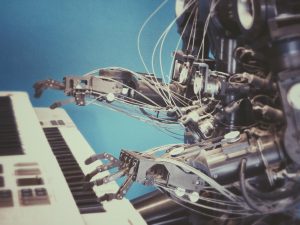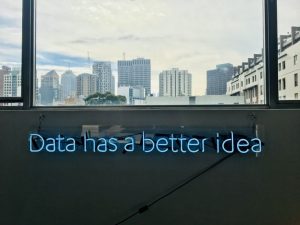The rapid adoption of AI technologies shows that they cater to the needs of businesses.
What AI Means for Business
Today, Artificial Intelligence and Machine Learning are seen as part of the everyday life of large organizations in various fields. The rapid pace of AI development – achievements in unmanned aerial vehicles, the ability to beat humans at chess and poker, automated customer service and analytical systems – shows that AI is a revolutionary technology designed to change the way people use devices and conduct business.
The appearance of intelligent machines capable of solving difficult problems in a way that only humans could previously hasn’t gone unnoticed. From the day of its invention until now, the AI technology has been evolving and improving. Due to its ability to learn, AI is widely used in many spheres. Particular applications of AI include expert systems, Speech Recognition, Machine Learning, and Machine Vision.
According to the 2019 CIO Survey by Gartner, the number of companies implementing AI technologies in some form has grown by 270 percent in the past four years, and by 37 percent in the past year alone.
It’s worth mentioning that AI in this context doesn’t relate to actual self-aware intelligence machines in a pure form. Rather, it can be considered a general term for a range of applications used by website and mobile app developers. They include image and Speech Recognition, Cognitive Computing, Automatic Analysis, and Machine Learning.
There are two main factors driving the fast adoption of AI. The first is access to high-quality, adaptable learning models. The second is the need to manage large amounts of data in a cheaper and more effective way instead of investing heavily in massive infrastructure.
The Difference Between AI and ML
 https://unsplash.com/photos/U3sOwViXhkY
https://unsplash.com/photos/U3sOwViXhkY
AI: As Artificial Intelligence and Machine Learning have become integral for many businesses, the terms are often used interchangeably. However, this is inaccurate. Let’s look into these technologies more closely to understand the difference between them and how to tell them apart.
AI is a broad term that describes advanced computer intelligence. AI can include anything from programs for playing chess to voice recognition assistants such as Apple’s Siri and Amazon’s Alexa. All AI technology falls into one of three categories: narrow or weak AI, Artificial General Intelligence (AGI), and Superintelligent AI.
IBM’s program known as Deep Blue that beat Garry Kasparov at chess in 1996, and Google DeepMind’s AlphaGo, which beat Lee Sedol at Go in 2016, are examples of narrow AI. These systems were designed to perform only one task or solve only one problem. Artificial General Intelligence, on the contrary, is considered to be on the same level as the human brain, as it can perform a wide range of tasks.
Superintelligent AI is more advanced than Human Intelligence. According to AI guru Nick Bostrom, Superintelligent AI can be described as “an intellect that is much smarter than the best human brains in practically every field, including scientific creativity, general wisdom, and social skills.” The time may come when machines surpass us on the intellectual level.
ML: Machine Learning is just one of the many applications of AI. The key principle of Machine Learning is that machines receive data and teach themselves based on it. These days, ML tools are the most highly demanded AI-powered tools for businesses. Machine Learning systems are capable of applying knowledge acquired via training from enormous sets of data in order to excel at facial and speech recognition, object recognition, translation, chatbots, etc. While a hand-coded program requires specific instructions to complete a task, ML learns to recognize patterns on its own to predict the next step.
Deep Blue and DeepMind are types of AI. However, Deep Blue was based on a certain set of rules, so it can’t be considered a Machine Learning system. Meanwhile, DeepMind’s AlphaGo is a perfect example of an ML algorithm: it managed to beat the world champion in Go because it learned expert moves from experienced players by analyzing a large amount of data.
How Machine Learning Works
 https://unsplash.com/photos/qwtCeJ5cLYs
https://unsplash.com/photos/qwtCeJ5cLYs
So how exactly do machines teach themselves? According to the commonly accepted definition, ML is the ability for computers to learn and act without being explicitly programmed. To enable this self-learning function, ML uses two techniques: supervised learning and unsupervised learning.
Supervised learning involves training a model on a known set of input data and known responses to that data (outputs) so it can predict future responses to new data. In turn, supervised learning uses classification and regression techniques to develop predictive models.
Classification techniques predict discrete responses by classifying input data into categories or classes. This type of ML is usually applied for image classification, diagnostics, identity fraud detection, and speech recognition. For instance, ML can say whether an email is genuine or spam or whether a tumor is malignant or benign.
Regression techniques predict continuous responses to constantly changing or developing data. They help a lot when it comes to weather forecasting, advertising popularity predictions, market predictions, and algorithmic trading.
Organizations usually choose supervised learning when their goal is to train a model to make a prediction regarding the future value of a continuous variable, such as temperature or a stock price (regression), or to identify makes of cars from webcam video footage (classification).
Unsupervised learning models are capable of finding hidden patterns and intrinsic groupings within input data and don’t require knowledge of the output for this.
The most typical unsupervised learning technique is clustering. Applications of cluster analysis include gene sequence analysis, recommender systems, targeted marketing, and object recognition.
In practice, clustering can be implemented like this: Let’s say a cell provider wants to figure out the best places to locate their cell phone towers. For this, they need to acquire information about the number of users concentrated in each specific area around the company’s existing towers. Machine Learning can estimate this number. As a phone can receive a signal only from one tower at a time, the telecom operator can use a clustering algorithm to determine the best placement of cell towers to optimize signal reception for different groups (clusters) of customers.
Organizations usually rely on unsupervised learning if they need to explore their data and train a model that will split data into clusters.
Applications of ML
 https://unsplash.com/photos/1K6IQsQbizI
https://unsplash.com/photos/1K6IQsQbizI
Machine Learning has made its way into a variety of human activities. The most common uses of Machine Learning are in the following four sectors:
Business. Almost every organization dealing with customer service has embraced AI technology in one one way or another. Machine Learning algorithms are being widely integrated into analytics and CRM platforms to uncover information on how to better serve customers. Chatbots are being added to websites and mobile apps to provide immediate responses to visitors and users.
Adding ML to a mobile app has become a common request from business owners. Mobile app developers have learned fast how to integrate machine learning into Android and iOS apps. Apple offers developers their own Machine Learning frameworks: Core ML and the Create ML app.
Education. ML models can automate grading, giving teachers more time to concentrate on other aspects of education. Other programs are capable of assessing students in their study, adapting to their needs and level and helping them work at their own pace. There are even AI tutors that provide support to students, ensuring they stay on track.
Healthcare. ML algorithms are widely integrated in medical applications. With the help of Machine Learning, doctors can make better and faster diagnoses and predict patient outcomes sooner.
Chatbots are also being actively applied by Healthcare service providers, as these online programs can assist patients in many ways such as scheduling appointments, answering common questions, aiding in the payment process, and even providing basic virtual diagnostics.
Manufacturing. Industrial companies have been at the forefront of incorporating robots into the workflow. Industrial robots have helped to automate and optimize certain processes and tasks previously performed by humans. This has helped to increase the volumes of manufactured products and reduce labor costs.
Which ML Frameworks Should You Consider?
Since hardware, software, and staffing costs for AI can be high, many vendors are including AI components and access to AI as a Service (AIaaS) platforms as part of their standard offerings. This way, organizations get a chance to test AI-powered tools, especially programs with integrated ML, for various business purposes and sample multiple platforms before making a commitment. The most popular ML frameworks include Microsoft Cognitive Toolkit, Amazon Machine Learning, and PyTorch.
Microsoft Cognitive Toolkit (CNTK). Microsoft created CNTK as a training algorithm for machines to learn like humans. However, CNTK is used to create various Machine Learning models – for instance, feed-forward DNNs, recurrent neural networks, and convolutional neural networks. Thanks to CNTK, it becomes easier for neural networks to process huge amounts of unstructured data. The toolkit also offers rapid training and intuitive architecture. It can be customized as per your requirements because it lets you select your metrics, networks, and algorithms.  https://www.google.com/url?sa=i&source=images&cd=&ved=2ahUKEwjwxpKjspHkAhUKhxoKHSjLAKsQjRx6BAgBEAQ&url=https%3A%2F%2Fmarketingland.com%2Fstartup-pyze-launches-free-business-intelligence-personalization-platform-mobile-apps-170806&psig=AOvVaw0xx9B2XxgZmDtY-xQlghcZ&ust=1566388270227304
https://www.google.com/url?sa=i&source=images&cd=&ved=2ahUKEwjwxpKjspHkAhUKhxoKHSjLAKsQjRx6BAgBEAQ&url=https%3A%2F%2Fmarketingland.com%2Fstartup-pyze-launches-free-business-intelligence-personalization-platform-mobile-apps-170806&psig=AOvVaw0xx9B2XxgZmDtY-xQlghcZ&ust=1566388270227304
Amazon ML. Amazon’s Machine Learning framework comprises a set of tools to create highly sophisticated, intelligent, and high-end applications without code. AML provides predictions for the desktop and mobile applications using APIs and can connect applications to the cloud.
PyTorch. This tool serves as an ML library and scientific computing framework at the same time. PyTorch is flexible and offers high-end efficiencies and speed. It also offers a lot of pretrained modules. It can be used for building deep neural networks, is Lua-based, and runs on Python. A lot of big companies including Facebook, IBM, and Yandex rely heavily on the PyTorch framework.
The Bottom Line
As you can see, AI is capable of greatly facilitating the workflow of different organizations. That’s why adoption of this technology is moving at a breathtaking pace. Seasoned companies along with fresh-baked startups are integrating Machine Learning and Deep Learning algorithms into their applications to offer advanced features to end users. Healthcare, Business, Education, and Manufacturing are only some of the sectors using ML applications. The continuous development of AI in general and Machine Learning in particular is leading to new opportunities for business owners and new markets for services.
Read more: The Role of Artificial Intelligence in Transforming Customer Experience






 https://www.google.com/url?sa=i&source=images&cd=&ved=2ahUKEwjPlMbxspHkAhURqxoKHaeqCx4QjRx6BAgBEAQ&url=%2Furl%3Fsa%3Di%26source%3Dimages%26cd%3D%26ved%3D%26url%3Dhttps%253A%252F%252Fwww.inverness-chamber.co.uk%252Fevents%252Fevent%252Fgigabit-city-inverness%26psig%3DAOvVaw0xx9B2XxgZmDtY-xQlghcZ%26ust%3D1566388270227304&psig=AOvVaw0xx9B2XxgZmDtY-xQlghcZ&ust=1566388270227304
https://www.google.com/url?sa=i&source=images&cd=&ved=2ahUKEwjPlMbxspHkAhURqxoKHaeqCx4QjRx6BAgBEAQ&url=%2Furl%3Fsa%3Di%26source%3Dimages%26cd%3D%26ved%3D%26url%3Dhttps%253A%252F%252Fwww.inverness-chamber.co.uk%252Fevents%252Fevent%252Fgigabit-city-inverness%26psig%3DAOvVaw0xx9B2XxgZmDtY-xQlghcZ%26ust%3D1566388270227304&psig=AOvVaw0xx9B2XxgZmDtY-xQlghcZ&ust=1566388270227304





Comments are closed.